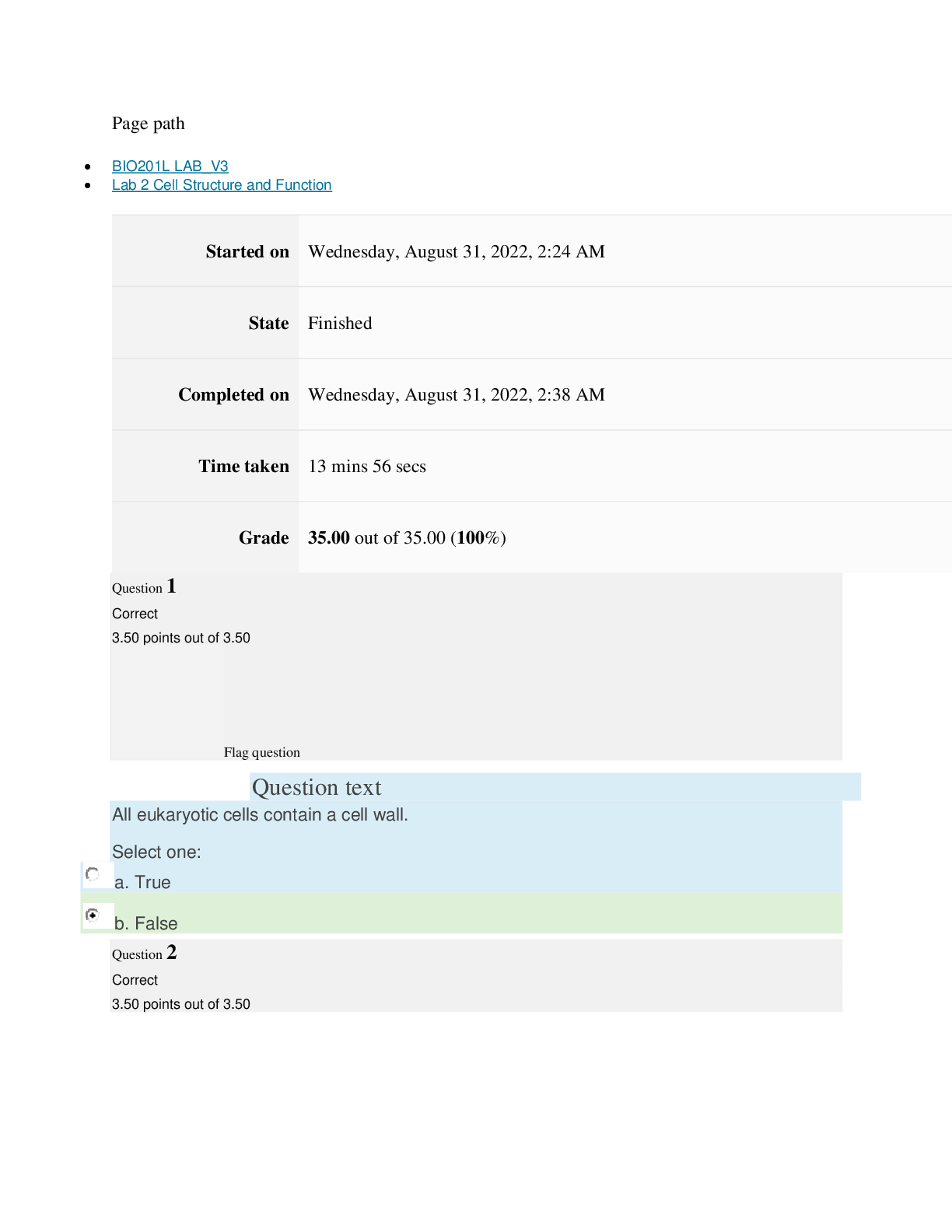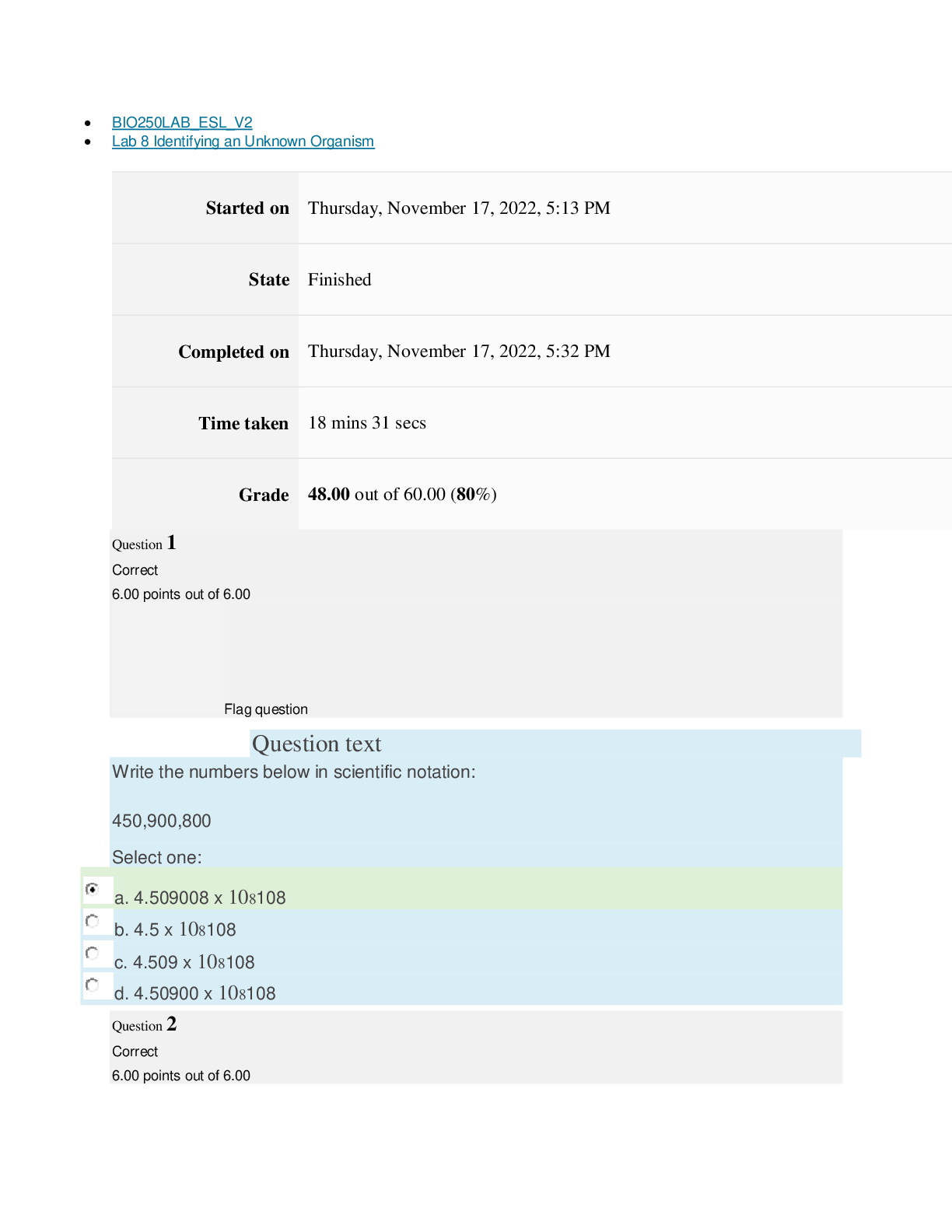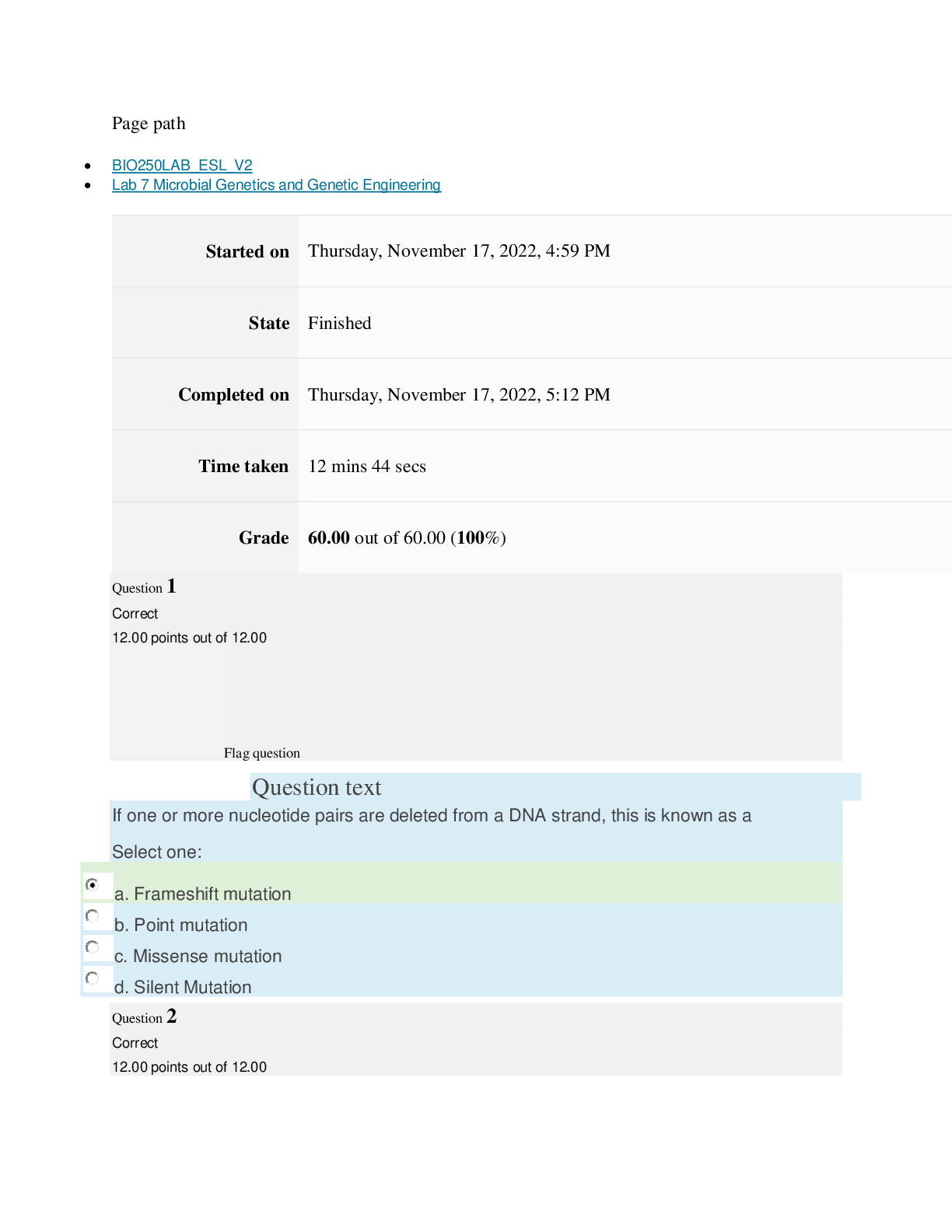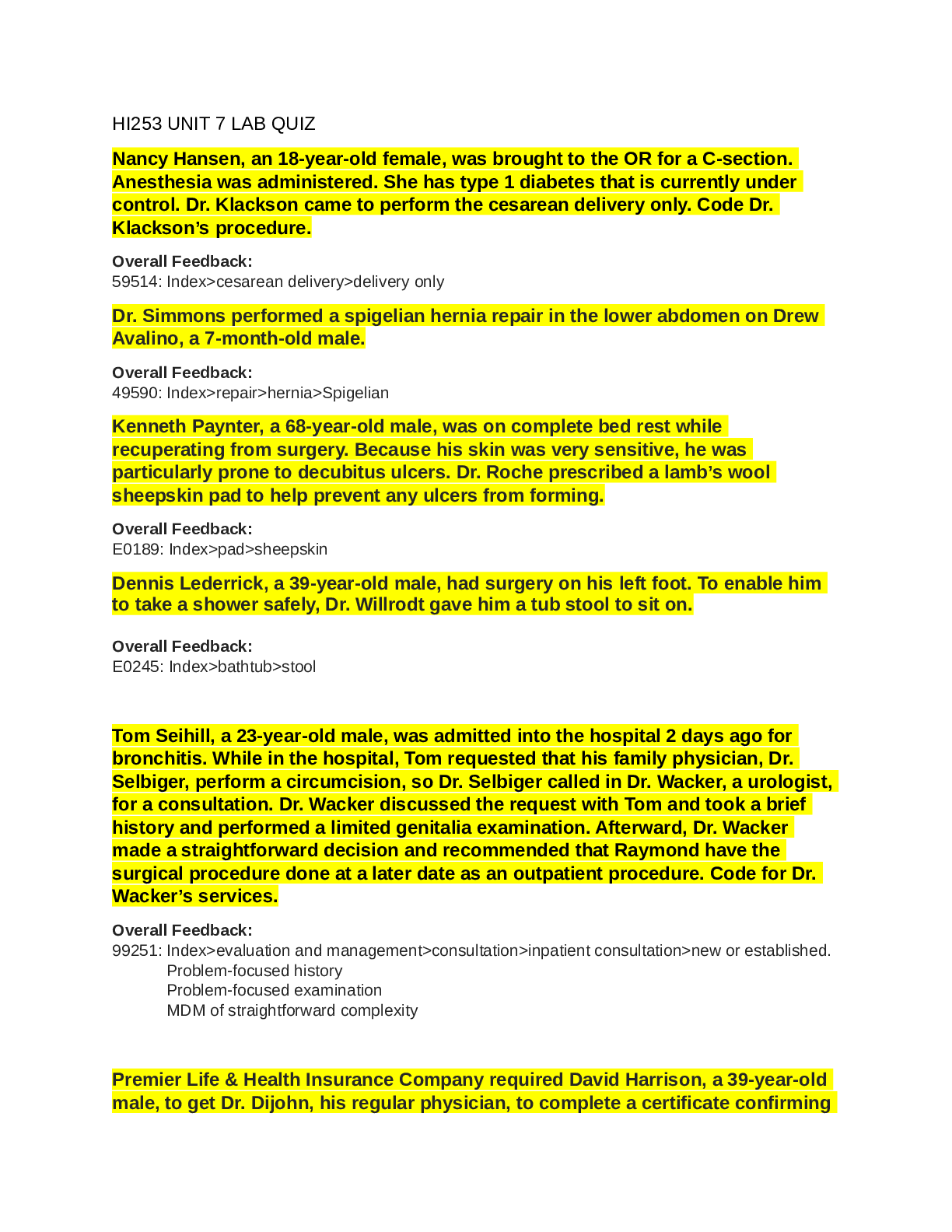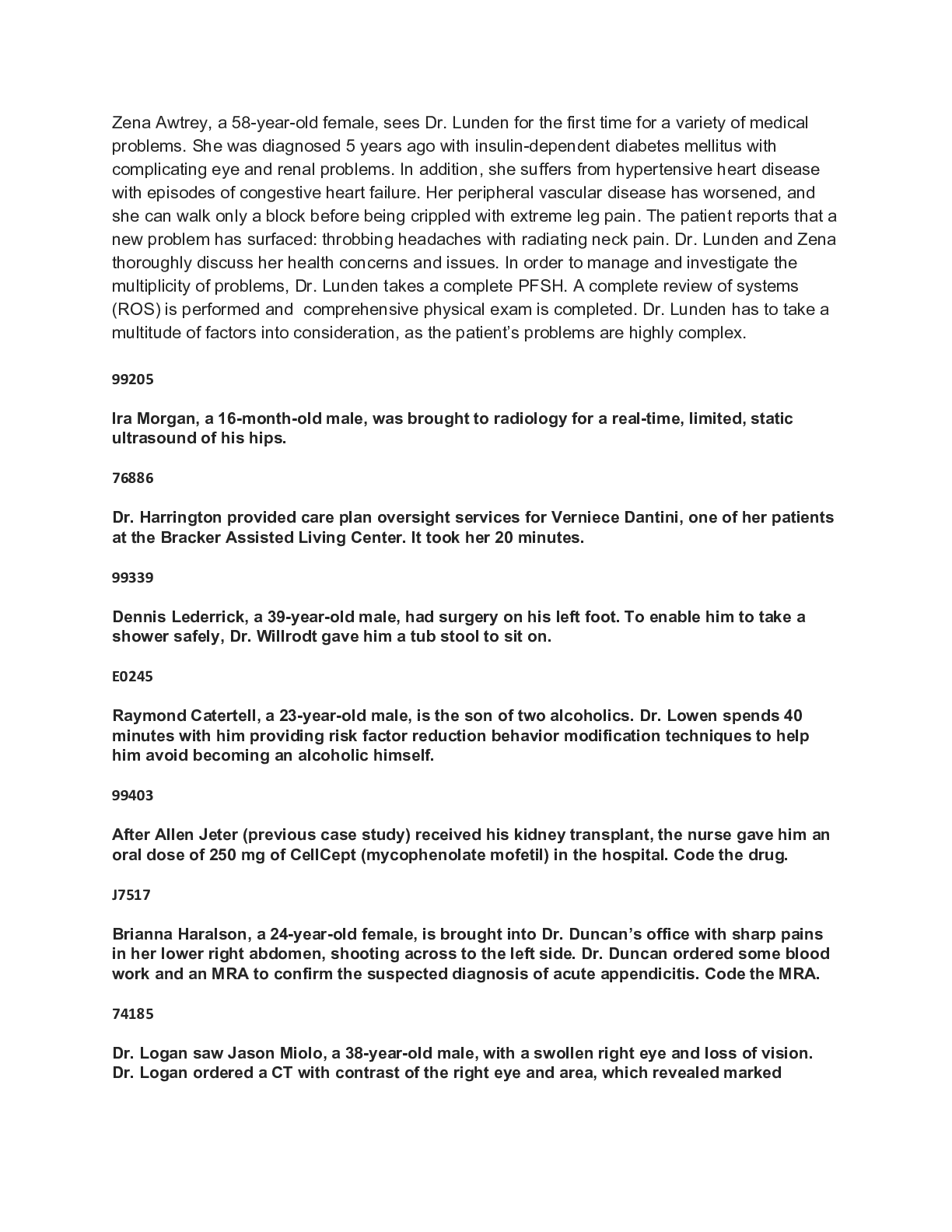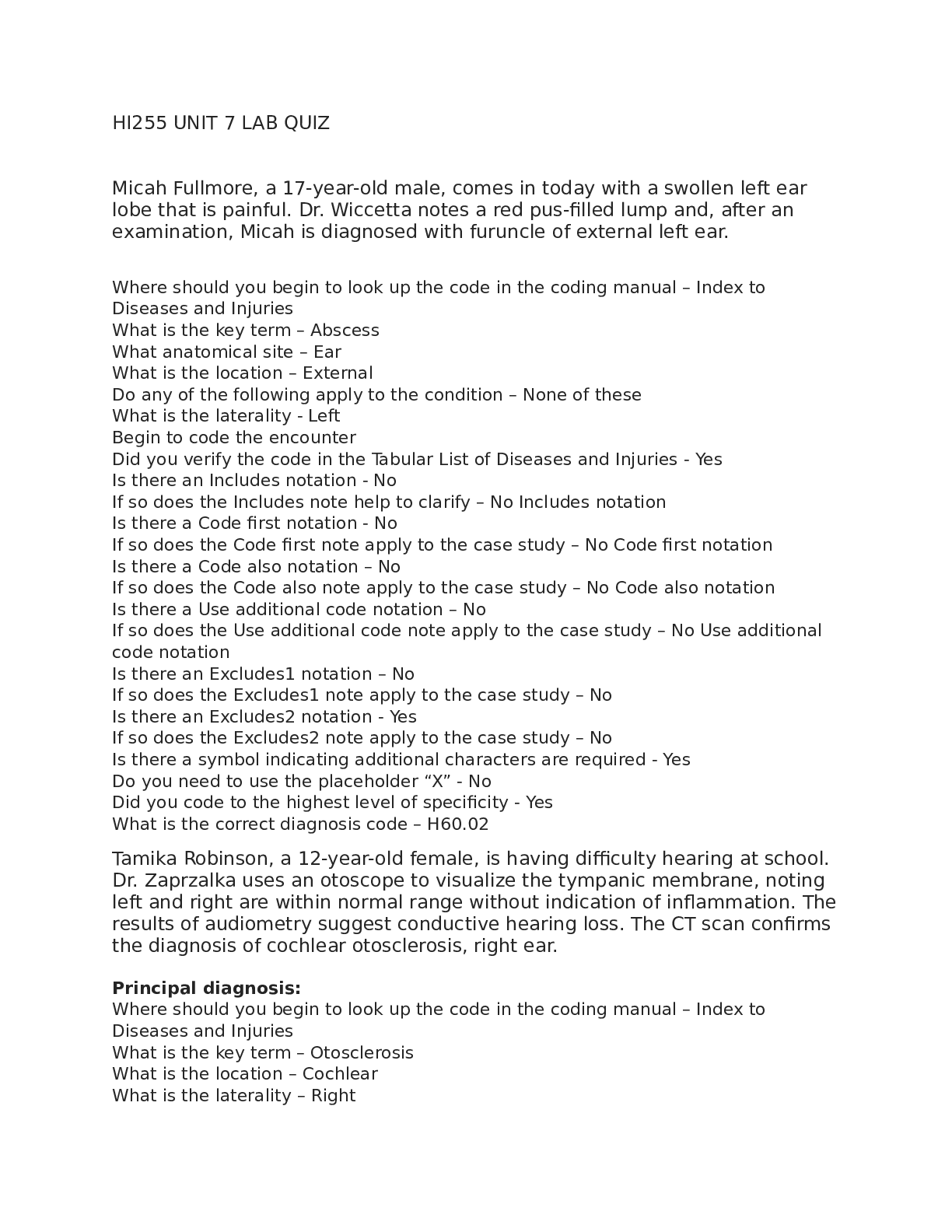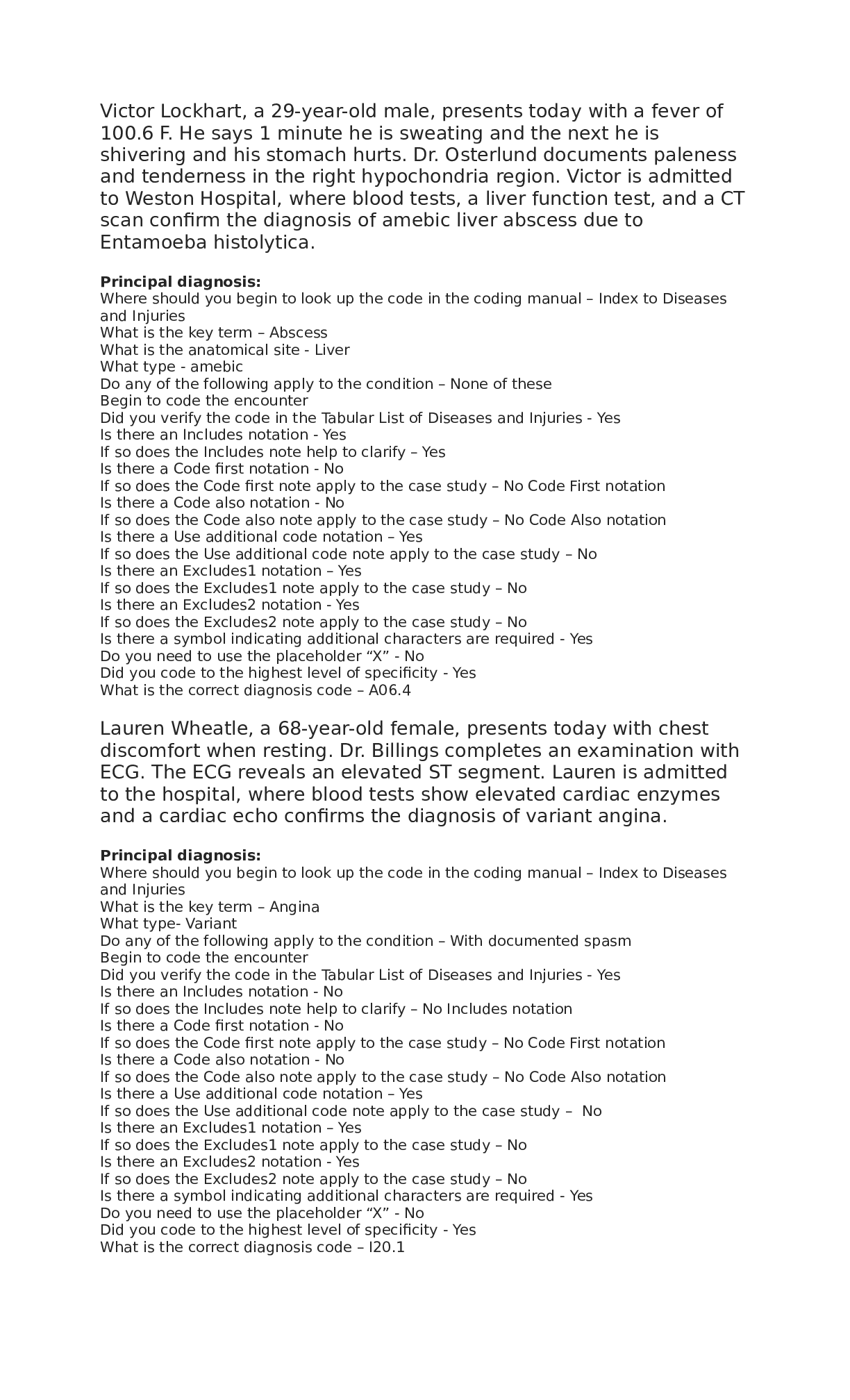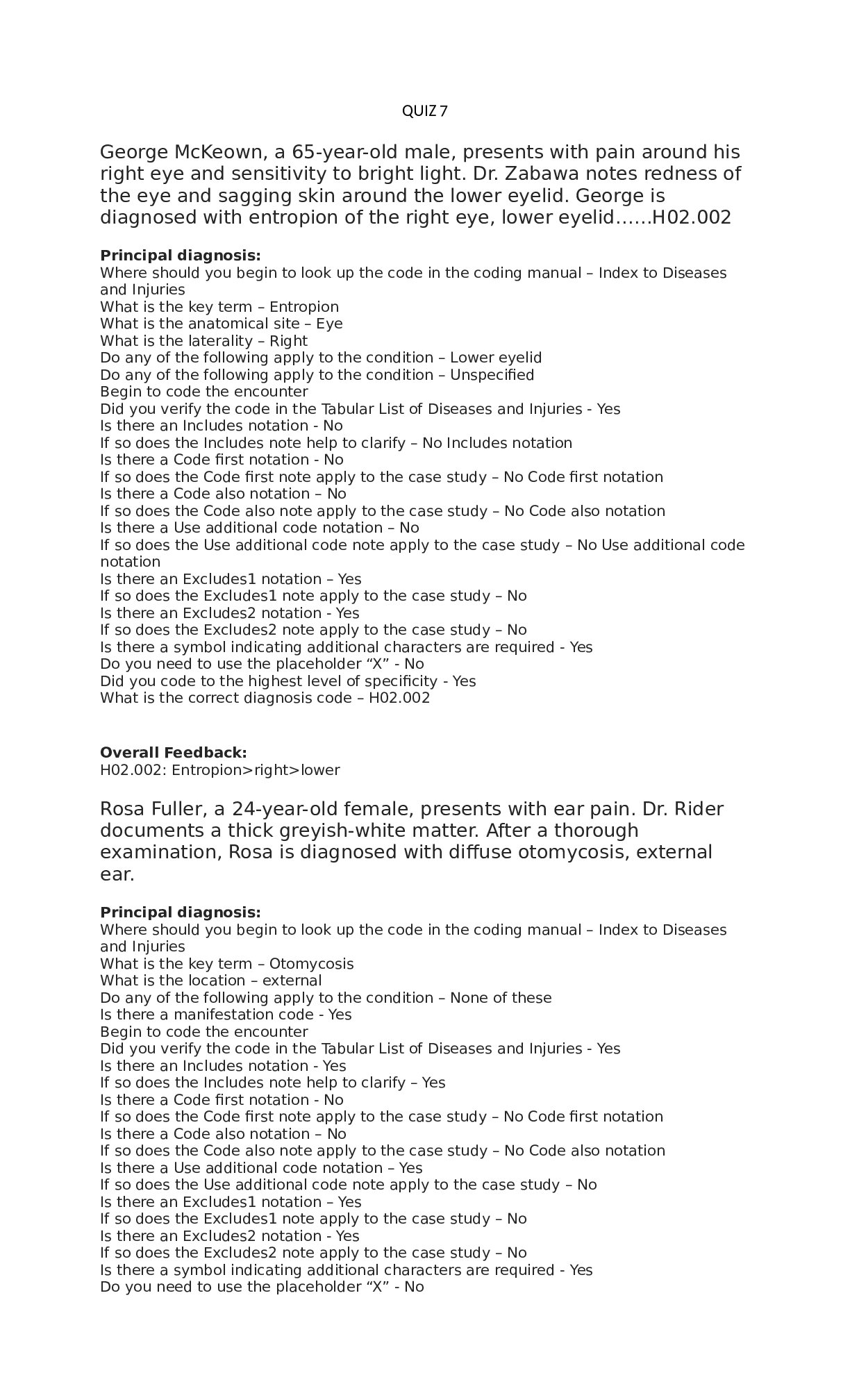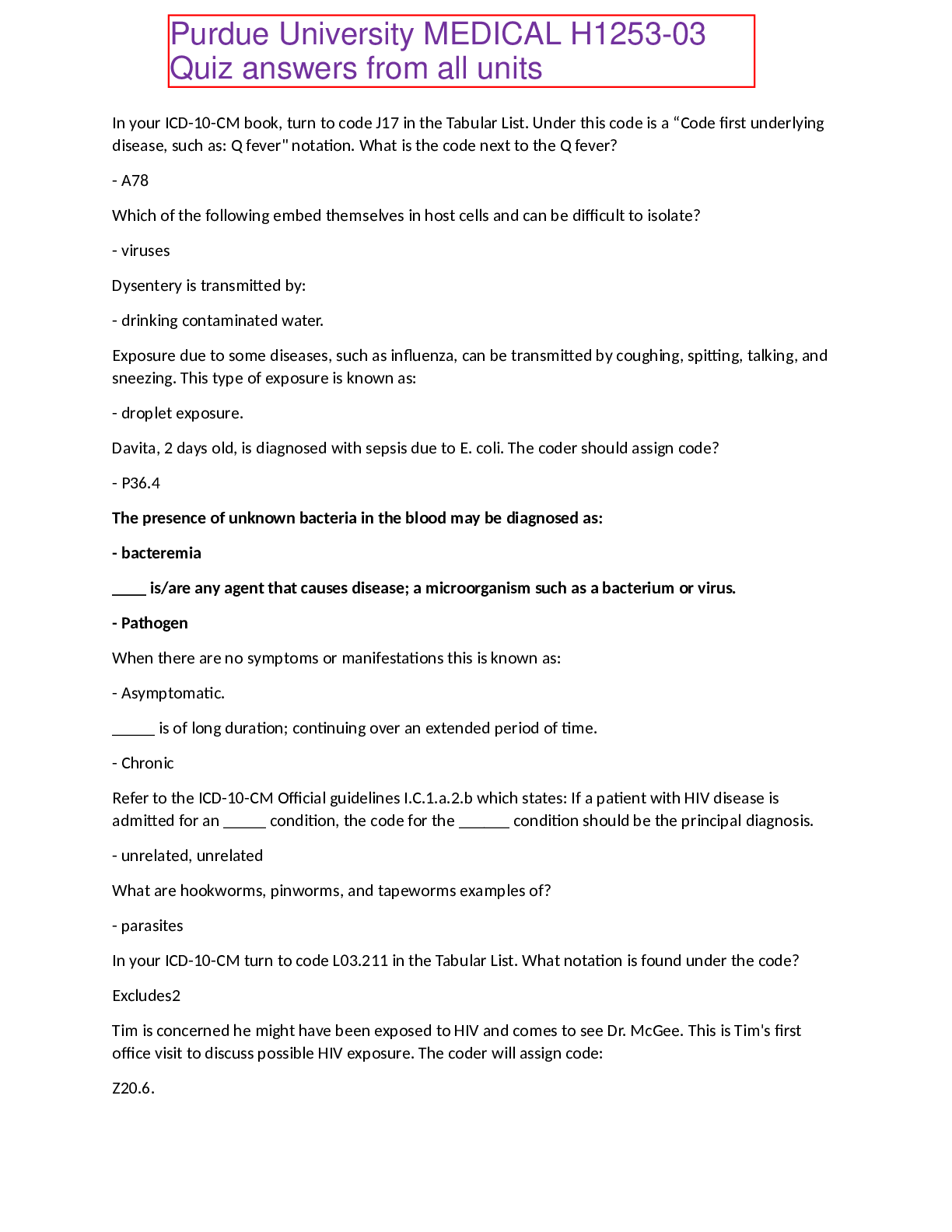Anatomy and Physiology - A&P 1 > LAB QUIZ > BIO201L Lab 7 The Muscular System[ALL ANSWERS 100% CORRECT] PRELAB Q&A (All)
BIO201L Lab 7 The Muscular System[ALL ANSWERS 100% CORRECT] PRELAB Q&A
Document Content and Description Below
Lab 7 The Muscular System BIO201L Student Name: Latoya Tulloch Access Code (located on the lid of your lab kit): AC-7JYMXQH Pre-Lab Questions ”1. How do banding patterns change when a muscle cont ... racts?” The myosin myofilaments and actin decreases in lengt and compact closely following the contractrion of muscles. The A band lacks changes while both I and H zones narrows. ”2. What is the difference between a muscle organ, a muscle fiber, myofibril and a myofilament? ” The muscle organs composed of tissues involving fibers and cells that generate movement on the entire body resulting to contractions. The muscle fibers encompasses the myofibrils wich contract during activation and contail multiple nulei. The myofibrils involves thread-like sthructures comprised of myosin and actin. Myofilaments ar building components of the myofibrils. ”3. Outline the molecular mechanism for skeletal muscle contraction. At what point is ATP used and why? ” The ATP undergoes metabolic conversion to pi and ADP, following its bindinhg to myosin. The myosin heads develops cross bridges after the binding of troponin and calcium together to generate tropomyosin. When the pi and ADP are released, it results to sliding of the actin towards the sarcomere center to generate power stroke. Following the process, the ATP is consumed to facilitate body temperature and heart rate rise causing homeostasis. ”4. Explain why rigor mortis occurs. ” Rigor mortis occurs during partial contraction of the muslces and fails to enter relaxed state owing to lack of oxygen or blood flowin in the system. . Experiment 1: Tendons and Ligaments Post-Lab Questions ”1. Label the arrows in the slide images below based on your observations from the experiment. ” A- chondrocytes B- collagen C- collagen fibers D- skeletal muscle fiber E- nuclei F- collagen fibers Lab 7 The Muscular System BIO201L Lab 7 The Muscular System BIO201L ”2. How does the extra cellular matrix of connective tissues contribute to its function? ” served by promoting signal transduction, distinguishing between various tissue kinds, and offering support and shielding. ”3. Why are tendons and ligament tissues difficult to heal? ” Due to their inadequate or insufficient blood supply, tendons and ligaments were challenging to repair. ”4. What difference do you see between the tendon – muscle insertion image and the tendon image? ” The tendon muscle insertion contain dense irregular connctive sell tissue, collagen and chondrocytes while the tendon appear smooth moving in specified direction and comprise of a single nucleus. ”5. What differences do you see between the tendon and ligament sections? ” the tendons are closesly packed togethe and separated while the ligaments are less densly packed and are skeletal muscle fibers. Lab 7 The Muscular System BIO201L Experiment 2: The Neuromuscular Junction Post-Lab Questions ”1. Are there few or many nuclei at the end plate? ” Numerous ”2. What is a motor unit? ” Motor unit entails a single motor neuron, including th entire muscle fibers innerveted by it and work together to produce a contraction in one muscle ”3. How is a greater force generated (in terms or motor unit recruitment)? ” A single motor neuron generates a signal over thousands of motor neurons that are responsible of rectuiting muslce fibres which produce enhanced force. ”4. What types of sensors are present within the muscle to identify how much force is generated? ” muscle spindles that indefies the muscle length, golgi tendons responsble for muscle tension and pacinian corpuscles in charge of pressure variations. Experiment 3: Muscle Fatigue Table 2: Experimental Counts Trial 1 Trial 2 Trial 3 Trial 4 Trial 5 Predicted Value 20 20 20 20 15 Actual Value 20 20 20 20 15 Post-Lab Questions ”1. How did the predicted results compare to the actual results? ” The actual outcomes are very similar to what was projected. The results each ranged around five of one another. ”2. Did you notice any changes in the number of repetitions you could perform, or how your hand felt after each of the trials? ” During the final attempt, I managed only complete 15 of tasks rather than 20, and by the ending I was significantly worn out. ”3. Explain the actions that were occurring at the cellular level to produce this movement. Include sources of energy and any possible effect of muscle fatigue. ” With this workout, ATP predominates over other energy systems, with assistance from the anaerobic and aerobic glucose metabolism. That results in lactic acids accumulation, oxygen depletion, and weariness. ”4. Hypothesize what would happen if blood flow was restricted to the hand when this experiment is performed. ” [Show More]
Last updated: 3 years ago
Preview 1 out of 16 pages
![Preview image of BIO201L Lab 7 The Muscular System[ALL ANSWERS 100% CORRECT] PRELAB Q&A document](https://scholarfriends.com/storage/new lab worksheet 7.png)
Buy this document to get the full access instantly
Instant Download Access after purchase
Buy NowInstant download
We Accept:

Also available in bundle (1)
Click Below to Access Bundle(s)
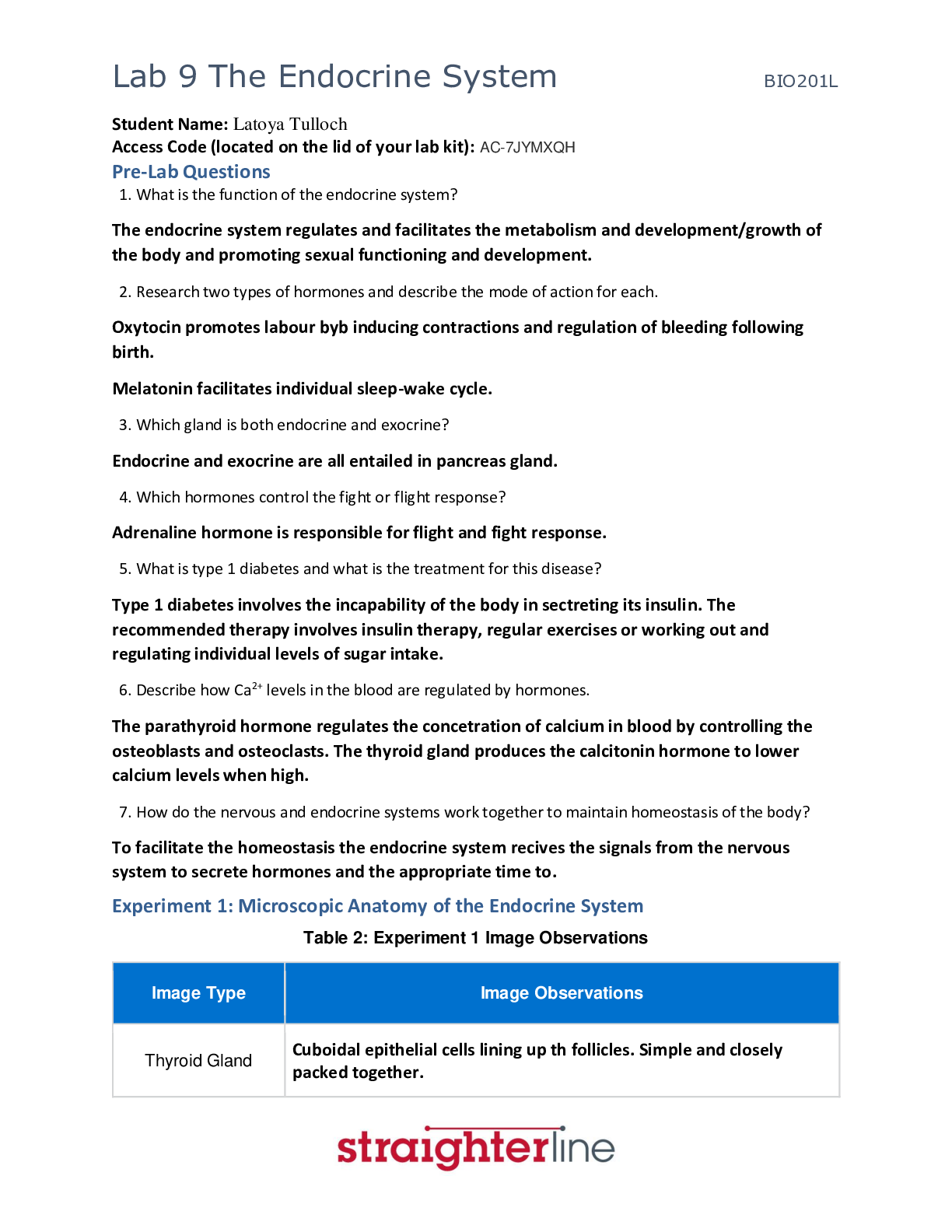
ANATOMY & PHYSIOLOGY 1 BUNDLED BIO201 PRE-LAB Q&A [QUESTIONS AND ANSWERS,, LATEST WITH VERIFIED SOLUTIONS]
Lab 1 Introduction to Science Lab 2 Cell Structure and Function Lab 3 Mitosis and Meiosis Lab 4 Diffusion and Osmosis Lab 5 Tissues and Skin Lab 6 The Skeletal System Lab 7 The Muscular System...
By QuizMaster82 3 years ago
$25
9
Reviews( 0 )
$10.00
Can't find what you want? Try our AI powered Search
Document information
Connected school, study & course
About the document
Uploaded On
Dec 04, 2022
Number of pages
16
Written in
All
Additional information
This document has been written for:
Uploaded
Dec 04, 2022
Downloads
0
Views
157









